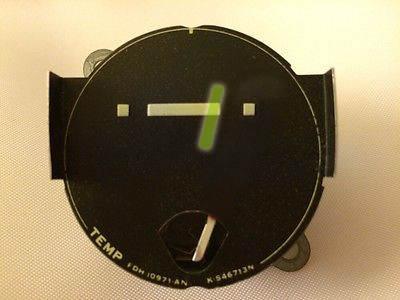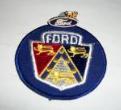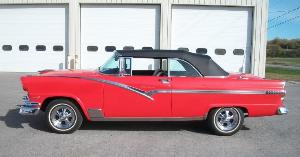|
Author
|
Message
|
|
Half-dude
|
 Posted 9 Years Ago
Posted 9 Years Ago
|
|
Group: Forum Members
Last Active: Last Week
Posts: 227,
Visits: 11.3K
|
Hey guys I've posted topics about this before, but I've got some more concrete information now that my car is running well enough to drive long distance. It's about the temperature the engine seems to hover at. After about half and hour of 50ish mph driving on country roads, the temperature gauge reads just about at the far end of the solid white line, hovering a little higher little lower from then on out.  Now I'm not expert on classic engines so the condition of the engine after stopping again when reaching this temperature I'm not sure if they're normal or not. After reaching our stop I lifted the hood to let it cool down a little, there was white/grey some coming from the oil breather, a dribble of coolant coming from the radiator overflow tube, and the inside of the radiator was making a gurgling sound every say.. 2 seconds.
|
|
|
|
|
miker
|
|
|
Group: Forum Members
Last Active: 2 Months Ago
Posts: 1.9K,
Visits: 194.9K
|
I don't remember your previous post, but just a couple,comments. The factory gauges are notoriously inaccurate. The oil breather will show vapor after a long drive, with the oil warmed up. That's why I prefer a PCV system over a road draft tube, and a closed PCV over an open one. If you shut the engine off hot, it will heat soak and gain temperature at the top of the thermostat housing and the radiator. That can be the gurgle you hear. If you don't have a catch can and a sealed radiator cap, you'll end up with air space at the top of the radiator. If you fill it, it just repeats the process. Keeping air out of the system, using coolant recovery, is what most modern cars do. But they're designed to run over 200 degrees or so. Go buy a cheap infrared thermometer. Check the temp at the top of the radiator and the themostat housing. Then, you'll know where the engine is running temp wise. You can check the bottom of the radiator too, and see the temperature drop. It's hard to believe, but I've seen several of these cheap ones run within 1/2 degree of a really expensive Fluke meter. Typical one from Amazon. http://www.amazon.com/Etekcity-Lasergrip-1080-Non-contact-Thermometer/dp/B00DMI632G/ref=sr_1_4?ie=UTF8&qid=1463631184&sr=8-4&keywords=infrared+thermometerYou're probably just fine if your running a 50/50 mix of antifreeze and a 10lb cap or so.
miker
55 bird, 32 cabrio F code
Kent, WA
Tucson, AZ
|
|
|
|
|
DryLakesRacer
|
|
|
Group: Forum Members
Last Active: Last Month
Posts: 1.7K,
Visits: 340.1K
|
I agree totally with miker. I have a meter like that from Harbor Freight and would never travel with out it. Great to check tire temps too. I do not have a recovery system on my 56-292 and always leave the coolant level down 1" . I learned the hard way with that, it was always pucking out a small amount of coolant if I didn't. I use a #7 cap.
On your short trips does the temp gauge slow come down on a down hill run. If it does your probably ok. Good Luck.
56 Vic, B'Ville 200 MPH Club Member, So Cal.
|
|
|
|
|
GREENBIRD56
|
|
|
Group: Forum Members
Last Active: Last Year
Posts: 1.7K,
Visits: 102.7K
|
If your engine was really "HOT" it would be boiling over - not just a little overflow - a lot. The gauges can be "re-tuned' to read a bit more accurately - but making a check with a real thermometer - infrared works best - to settle your digestion.....is a good idea. Overflow space is exactly as DLR described above - leaving room in the upper tank of the radiator. I'll try to hunt it down - but I used to have a photo of the opening on the back of the temp gauge where the needle position may be adjusted. The opening shows the edge of a cogged wheel where a small screwdriver can engage a tooth at a time. We had an ancient "wind-up" alarm clock that adjusted speed the same way, if you've seen one.

Steve Metzger Tucson, Arizona
|
|
|
|
|
paul2748
|
|
|
Group: Forum Members
Last Active: Yesterday
Posts: 3.7K,
Visits: 497.8K
|
Another way to check temperature at the radiator is to use an old fashioned thermometer (meat or one from the parts store(). Warm the engine up to where the gauge usually shows (don't put the cap on) and stick the thermometer in the water
54 Victoria 312; 48 Ford Conv 302, 56 Bird 312
Forever Ford
Midland Park, NJ
|
|
|
|
|
Half-dude
|
|
|
Group: Forum Members
Last Active: Last Week
Posts: 227,
Visits: 11.3K
|
Hey sorry for the delay,
Thanks to tall of you for your advice, it really is helpful and put me at ease some.
I've actually tried that temperature gun trick last year on the car, but that was before I put a colder thermostat in. but I think I remember the engine being around 190/200 degrees.
So do most of you guys use aftermarket gauges?
|
|
|
|
|
petew
|
|
|
Group: Forum Members
Last Active: 7 Years Ago
Posts: 178,
Visits: 5.0K
|
I put an aftermarket gauge in my 1955 tbird long enough to establish exactly what temp it was running at when fully warmed up which was 170 degrees. The factory gauge was indicating at the top of the white zone at 170 degrees. Seeing the gauge up so high was upsetting so I removed the factory gauge and very gently bent the needle towards the cold range . At 170 degrees the factory gauge now points right in the middle of the white zone .
Guess that was a "calibration" that I performed.
|
|
|
|
|
charliemccraney
|
|
|
Group: Moderators
Last Active: Yesterday
Posts: 6.1K,
Visits: 443.0K
|
190/200 degrees is nothing to worry about if it is stable at that temperature. A colder thermostat is not generally a good idea. It will have little, if any effect on the temperature because it controls the minimum operating temperature, not the maximum. If you have some problem causing it to overheat and it is not actually the thermostat causing the problem, then it is still going to overheat. A colder thermostat will reduce efficiency and increase wear.- not by an alarming amount, probably not even significant enough to be a concern for the typical collector vehicle, but increased wear nonetheless. I use an aftermarket gauge mostly because the factory one never worked in my ownership and the wiring under my dash is a mess. The thing I do like about a gauge that actually indicates the temperature is in the event that something does happen which results in the engine running hotter than normal.I can use the gauge to determine if I can make it home or need to call a tow truck.
Lawrenceville, GA
|
|
|
|
|
oldcarmark
|
|
|
Group: Forum Members
Last Active: 7 days ago
Posts: 3.7K,
Visits: 32.6K
|
I have a quality Aftermarket Mechanical Temp. Gauge under the Dash along with Oil Pressure, Voltmeter, and a Vacuum Gauge(Mileage Minder). I drilled and tapped Intake Manifold behind the Thermostat Housing to get a very accurate Temp reading of Coolant leaving the Rad. The Factory Temp Sender is in the Head at rear of Engine. Is that One reading High or Low compared to the placement of mine?
 
|
|
|
|
|
Half-dude
|
|
|
Group: Forum Members
Last Active: Last Week
Posts: 227,
Visits: 11.3K
|
Well that puts me at ease some then thank you very much!
Can any of you suggest some good models of instruments to use? I'd like to, as well, use one of those Temp/Amp/Oil Pressure clusters. My main issue is finding one where the Amp meter will read lower then 8 (I still have the original 6 volt system).
|
|
|
|